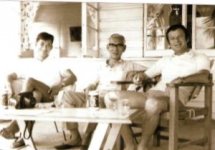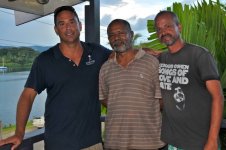The History of Fiji Pearls.

From what I understand and have read about the History of Pearling in Fiji:
There have been several attempts, mainly by Japanese companies, dating back to the 1950?s, to start pearling ventures in Fiji. Most of these attempts came under the Japanese ?Diamond Policy? (Pearls by Elisabeth Strack).
None of these companies really ?succeeded?. One individual however was very different then the rest of the companies coming into Fiji. He was and will always be known to me as Mr. Tokito. Mr. Tokito started his own pearling venture in the early 1960?s. He has never ?succeeded? in terms of producing the huge numbers of pearls, that pearling companies are always interested in, but he is still farming and has a wonderful family and really loves Fiji. (He has produced some exceptional pearls.)
Mr Tokito was absolutely instrumental to my growth and knowledge about pearling in Fiji. I?ve known Mr. Tokito since the mid 1990?s and have been very good friends with his son?s since the 1980?s.
Above is a rare picture of Mr. Tokito (far left), Mr. Wada, and Mr. Rosenthal. Mr. Tokito and Mr. Wada (master technician) had started a farm in Fiji in the very early 1960?s and had been producing some pearls. It was during these very early years that Mr. Tokito and Mr Wada were approached by Mr. Rosenthal (picture taken in Fiji at time of meeting).
Mr. Rosenthal and his brother were starting Tahiti?s first private sector pearl farm on Manihi atoll. The Rosenthal?s (famous French Family) had been tasked by France / French Polynesia to start French Polynesia?s first private pearl farm.
Both Mr. Tokito and Mr. Wada were asked to join the Rosenthal?s in Tahiti. Mr Wada eventually joined Mr. Rosenthal while Mr. Tokito stayed in Fiji.
Interesting to note that Mr Tokito said Mr Wada did not believe Fiji had enough oyster?s for a ?proper? pearling industry (true). But, Mr Tokito was happy to stay on and implant and harvest his own pearls and has had some 5 ? 7 different pearl farms all around Fiji over the last 40 years. He still farms, a little, and is always a great source for information and knowledge.
I started farming pearls in 1999. I was lucky to have quite a bit of aquaculture knowledge and extensive hatchery experience (Taylor Shellfish Farms, Washington State). We use both wild caught spat and hatchery shells to produce our pearls. Neither is consistent or easy.
Over the last 15 years I?ve seen probably 20 farms comes and go. Its just very complicated getting oysters, leases, and producing good quality pearls in Fiji.
Today J. Hunter Pearls Fiji works with two other local farmers; Civa Fiji owned by Claude and Danielle Prevost, and Valili Pearls, owned by local chief, Ratu Jone Maivalili. We all love what we do and take great pride in producing our unique Fiji Pearls. We work hand in hand to develop our industry.

Next Post will be back to pearls. We grade each line separately noting: technician, type of oyster, how and where oysters and pearls grew pre and post implant.
In several weeks I will have picks of the entire harvest.
Hope you enjoy.



